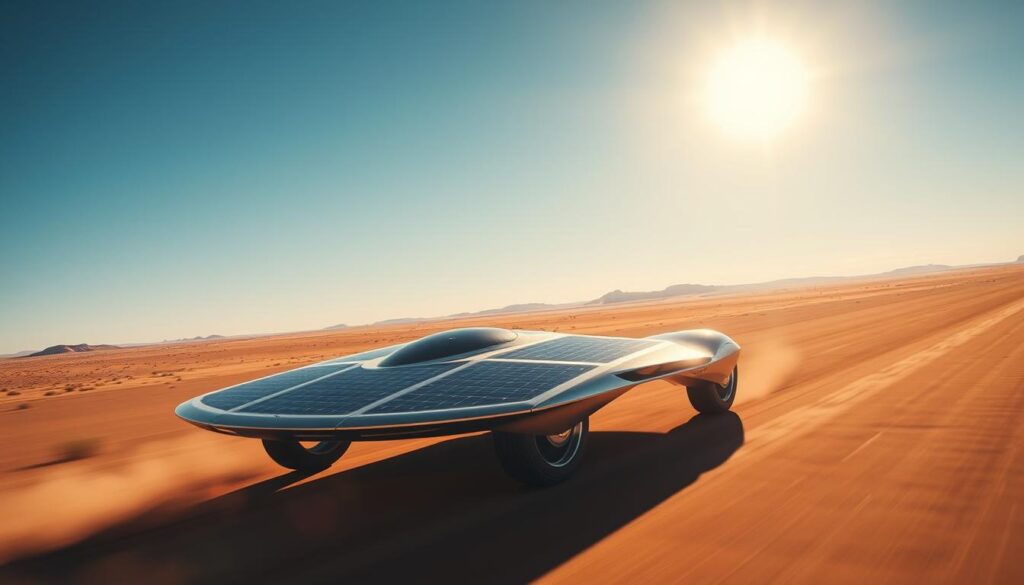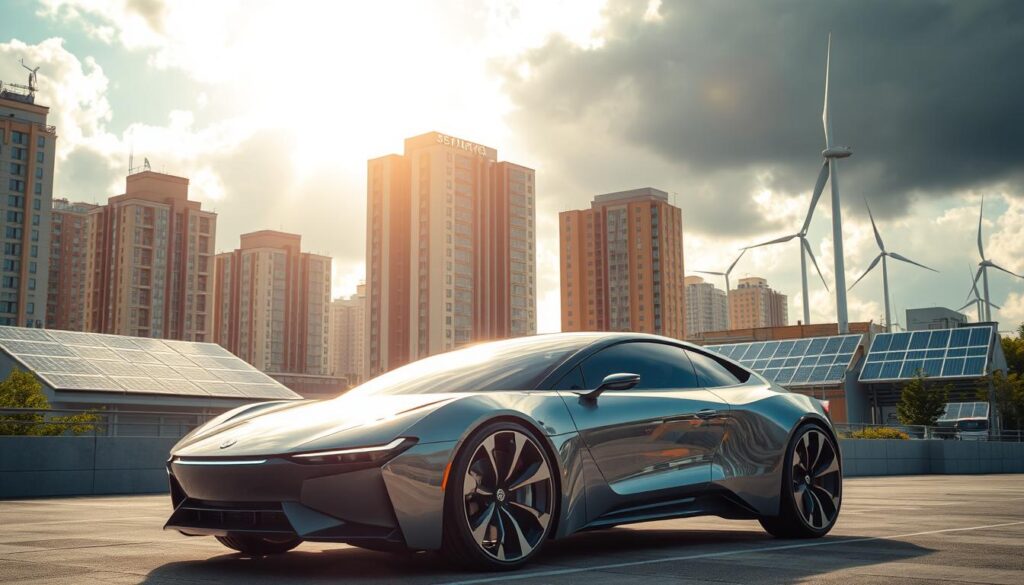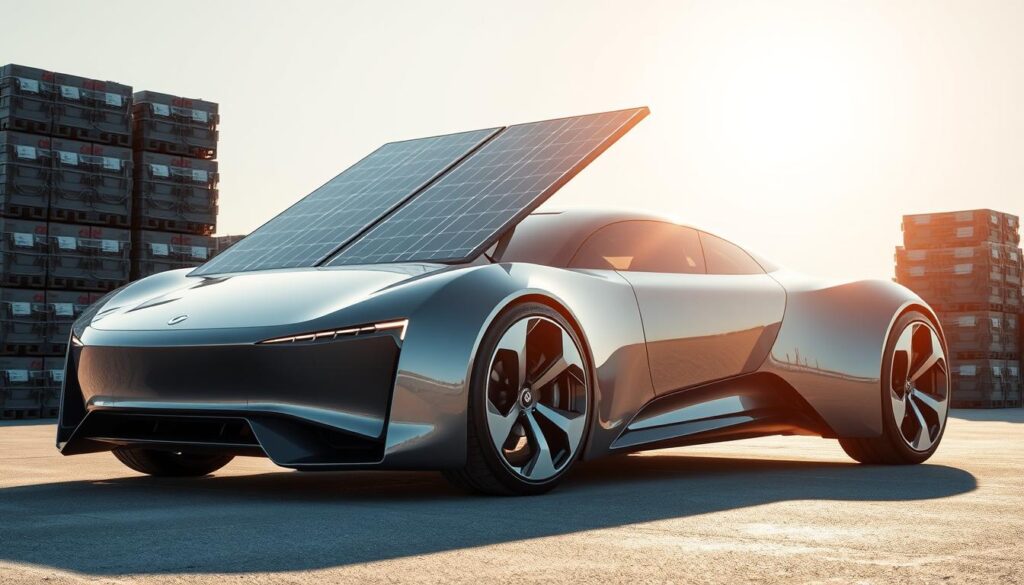Have you ever wondered why we’re not all driving solar-powered cars? It’s a question that has puzzled me for years. We have solar panels on roofs, so why not on our cars?
Solar vehicle technology isn’t new. It’s been around for a long time. But when I look out my window, I see gas-guzzlers and a few electric cars, not solar ones.
Renewable energy vehicles should be a big step towards a greener future. But they’re not yet a common sight. Let’s explore why solar-powered cars are still a dream rather than a reality.
Key Takeaways
- Solar-powered cars exist but aren’t common on roads
- Solar vehicle technology faces significant efficiency challenges
- Current solar cars are more concept than practical transportation
- Limited surface area on cars restricts solar energy collection
- Solar power output is far less than needed for highway speeds
- Automotive industry sustainability efforts include solar integration
The Allure of Solar-Powered Vehicles
I’ve always been drawn to the idea of solar-powered cars. They show us a future where we might not need fossil fuels anymore. But, I often wonder, why aren’t they here yet?
Renewable Energy on the Go
Solar cars use the sun’s energy to move, cutting out the need for gas. This could change how we travel and help fight climate change.
Reducing Dependence on Fossil Fuels
The way we travel is a big source of pollution. A car can release about 4.6 metric tons of CO2 each year. Solar cars could greatly reduce this number. Here’s how:
| Vehicle Type | Annual CO2 Emissions (metric tons) | Potential Reduction with Solar Power |
|---|---|---|
| Traditional Gas Car | 4.6 | 100% |
| Electric Car (Grid-Charged) | 1.9 | 100% |
| Solar-Powered Car | 0 | N/A |
The Promise of Self-Sustaining Transportation
Experts say solar cars could run for up to six months without needing a charge. This is exciting, as it could change how we travel.
“Solar-powered cars represent the ultimate dream of sustainable mobility – vehicles that can generate their own clean energy on the go.”
Despite their appeal, solar cars face big challenges before they’re common. Next, we’ll look at these obstacles and why we don’t see them on the road yet.
The World Solar Challenge: A Glimpse into the Future
I’ve always been fascinated by solar vehicle technology. The World Solar Challenge in Australia is amazing. Imagine sleek, futuristic cars racing across the Outback, powered by the sun!
The race is 3,000 kilometers long, from Darwin to Adelaide. It tests speed, endurance, and engineering. The cars are marvels of solar technology, designed to use every bit of sun’s energy.

These cars are unlike any family sedan. They have huge surfaces to catch more sun. They look like flying saucers, focusing on solar power over looks.
| Feature | Conventional Car | Solar Challenge Car |
|---|---|---|
| Power Source | Fossil Fuels | Solar Energy |
| Design Priority | Comfort and Aesthetics | Solar Panel Surface Area |
| Passenger Capacity | 4-5 People | Usually 1 Person |
| Window Area | Large | Minimal |
The 2023 World Solar Challenge was a game-changer. It showed solar cars have made progress but aren’t ready for daily use yet. But, each race brings us closer to a future where solar cars will be common.
The Solar Energy Conundrum: Not Enough Power
I’ve been trying to figure out why solar-powered cars aren’t on our roads yet. The main problem is there’s not enough power. Let’s look at why these cars can’t speed down our highways.
Limited Surface Area for Solar Panels
Imagine a car with as much space as two ping-pong tables. That’s not much room for solar panels. Even if we covered every inch, we’d still lack power.
Low Solar Panel Efficiency
Now, let’s talk about how well solar panels work. Today’s tech only turns about 20% of sunlight into electricity. That means 80% of the energy is lost. This low efficiency is a big problem for solar cars.
The Power Gap: Solar vs. Traditional Vehicles
Let’s compare the power of solar cars to traditional cars:
| Vehicle Type | Power Output | Highway-ready? |
|---|---|---|
| Solar Car (Theoretical) | 684 watts | No |
| Traditional Car | 20,000 watts | Yes |
That’s a huge power difference! Our solar car is like a toddler trying to keep up with the fastest man in the world. Until we improve solar panel efficiency and energy storage, solar cars will stay slow.
Why Aren’t Solar Powered Cars a Thing?
I’ve often wondered why we don’t see solar powered cars on the road. They seem like a great idea, but they’re not common. Let’s explore the challenges that make solar cars hard to find.

Generating enough power is a big problem. Cars don’t have enough space for solar panels to make enough energy. Even the best panels can’t give us enough power to drive far.
Where you live also matters. In places like Seattle, it’s hard to get enough sunlight. And driving at night means you need a big battery to store energy from the sun.
Batteries are also heavy. Adding solar panels makes the car even heavier. It’s like trying to fly with wings made of lead. It’s not efficient.
| Challenge | Impact |
|---|---|
| Limited power generation | Insufficient energy for practical use |
| Geographic limitations | Reduced efficiency in less sunny regions |
| Weight issues | Decreased overall vehicle performance |
| Cost-effectiveness | High production costs, limited market appeal |
Cost is another big issue. Solar cars are expensive. Until they’re cheaper, they won’t be a common choice for getting around.
Geographic and Weather Limitations
I’ve always been fascinated by solar vehicle technology. But, these vehicles face big challenges with geography and weather. It’s not all sunshine and rainbows for solar-powered cars!
Impact of Latitude on Solar Energy Collection
In the United States, sunlight changes a lot. Solar cars do great near the equator, getting lots of sun all year. But in Alaska, they’re not so good, especially in winter.
Seasonal Variations in Sunlight
Seasons affect solar car performance a lot. In summer, they zip around like they’re on a caffeine high. But in winter, they move as slow as a sloth. This makes it hard to count on solar power all the time.
Cloudy Days and Nighttime Driving Challenges
Cloudy days and rainy weather are bad for solar cars. On dark days, they might not even start. And driving at night is tough, unless we can use moonbeams for power.
| Condition | Solar Energy Collection | Driving Range |
|---|---|---|
| Sunny Day | Optimal | Maximum |
| Cloudy Day | Limited | Reduced |
| Night | None | Dependent on Stored Energy |
Solar cars face big challenges with geography and weather. This makes them less practical in many places. It shows that while solar cars are promising, we still have a lot to solve in the world of renewable energy vehicles.
The Weight Dilemma: Batteries and Solar Panels

I’ve always been fascinated by solar-powered cars. But there’s a big problem that stops them from becoming common. It’s not just about adding solar panels and batteries. The real challenge is balancing power generation with vehicle weight.
Adding solar panels and batteries makes a car heavier. It’s like running a marathon with a heavy backpack. The extra weight means the car needs more power to move, which can cancel out the benefits of solar energy. This is a big problem!
Let’s look at some numbers:
| Component | Average Weight | Impact on Performance |
|---|---|---|
| Solar Panels | 100-200 lbs | Increased drag, reduced efficiency |
| Battery Pack | 500-1000 lbs | Decreased range, slower acceleration |
| Additional Wiring | 50-100 lbs | Minor impact on overall weight |
Engineers face a tough challenge. They’re working to improve battery capacity and find new ways to store energy. It’s like a game of Tetris, where every piece must fit perfectly to make a car that works well for daily use.
So, when you dream of driving a solar car, remember it’s a big challenge. It’s all about finding the right balance between power and weight. We’re still figuring out the steps.
Current Solar Car Innovations and Startups
I’m excited to share some groundbreaking innovations in transportation. These are pushing the boundaries of automotive industry sustainability. Let’s dive into the world of solar-powered cars and the startups leading this charge.
Aptera’s Three-Wheeled Solar EV
Aptera’s futuristic three-wheeled solar electric vehicle is turning heads. This sleek machine can collect up to 40 miles of charge daily from sunlight alone. It’s a game-changer in the realm of innovation in transportation.
Lightyear One and Sono Sion: Solar-Electric Hybrids
Lightyear One and Sono Sion are pushing the envelope of solar-electric hybrid technology. Lightyear One boasts an impressive 7.45 miles per hour of solar charging. Sono’s Sion aims to provide an average of 69.5 miles per week from solar power. These advancements are reshaping our understanding of automotive industry sustainability.
Challenges in Solar Car Production and Adoption
Despite these exciting developments, solar car production faces hurdles. Cost-effective manufacturing, reliability concerns, and environmental factors affecting efficiency are key challenges. The industry must overcome these obstacles to make solar cars a mainstream reality.
| Solar Car Model | Solar Charging Capability | Key Feature |
|---|---|---|
| Aptera | Up to 40 miles/day | Three-wheeled design |
| Lightyear One | 7.45 miles/hour | Efficient solar-electric hybrid |
| Sono Sion | 69.5 miles/week (avg) | Integrated solar body panels |
As these startups continue to innovate, we’re inching closer to a future where solar-powered cars become a common sight on our roads. The journey is challenging, but the potential for sustainable transportation is immense.
The Future of Solar Technology in Automobiles
I’m really excited about the future of solar cars! It feels like we’re on the edge of a big change in how we travel. Imagine cars that run on sunlight, moving without using any fossil fuels. It’s not just a dream anymore; it’s happening.
Scientists are working hard to solve the problems holding us back. They’re making solar panels for cars that work better and cost less. I’m watching some amazing work at Linkoeping University in Sweden. They’re making new solar cell materials that could change the game for green and efficient cars.
But what’s even more exciting is the idea of combining solar with other green energy sources in cars. This mix could be the key to making cars truly eco-friendly. It’s like creating a team of superheroes, each with their own special power.
As we move towards a future powered by the sun, I feel a thrill of anticipation. The future of car technology looks bright, literally! Soon, we might all be driving cars that are like big solar panels. That’s a pretty optimistic view!
FAQ
What is the allure of solar-powered vehicles?
What event showcases the potential of solar-powered vehicles?
Why aren’t solar-powered cars more efficient?
What challenges prevent mainstream adoption of solar-powered cars?
How do geographic and weather conditions affect solar car efficiency?
What is the weight dilemma with solar-powered cars?
What are some current solar car innovations and startups?
What is the future of solar technology in automobiles?
Source Links
- Why aren’t there solar-powered cars on our roads? – https://www.popsci.com/technology/why-arent-there-solar-powered-cars/
- Why don’t solar-powered cars exist? – https://www.motorauthority.com/news/1132588_why-don-t-solar-powered-cars-exist
- Solar powered cars could soon hit the streets — but can they be efficient enough to go mainstream? – https://www.freethink.com/technology/solar-powered-cars
